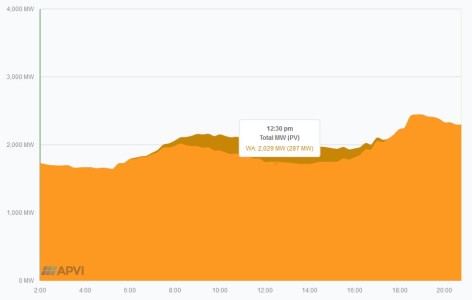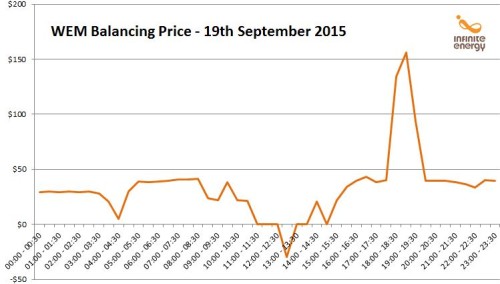Negative daytime prices in WA's Wholesale Electricity Market
WA's Wholesale Electricity Market price went into negative territory during the day for the first time in history on Saturday.
Negative prices in WA's Wholesale Electricity Market (WEM) are nothing new - they have in the past only occurred on windy nights when winds farms are producing at near capacity and consumption across the South West Interconnected System (SWIS) falls. Generators will then compete to stay connected to the grid and supply the electricity required by the system. Negative prices during the day are perhaps are a sign of things to come for the WEM as the march of Solar PV continues unabated.
According to the Australian PV Institute's Live Solar Mapping Tool, WA's combined Solar PV output on Saturday 19th September 2015 at 1230pm totaled 287MW (from a total of 485MW of installed solar nameplate capacity).

Note: the dark orange area depicts the estimated demand being supplied by "behind the meter Solar PV". Source: Australian PV Institute Live Solar PV Tool
The was enough to reduce demand on the SWIS to 1661MW and the Balancing Price to $-29.51 MWh . This was also assisted by a particularly windy day meaning wind farms on the SWIS were also producing near capacity.

Source: Independent Market Operator WA
In analysis performed by Infinite Energy, the Balancing Price would have been +$39.89 MWh had no Solar PV been generating at that time.
Other interesting outcomes:
- The combined output of WA's Solar PV Systems was the largest source of Electricity Generation on the day
- Two further negative intervals of prices occurred the following day (Sunday 20th September), although the price only dipped to $-1.00 MWh
- Daily Peak demand in the shoulder periods of the year (Autumn and Spring) is well and truly entrenched into the early evenings (6pm to 730pm).
- Solar is not having an effect on the shoulder period peaks into the later evenings but is contributing to lower the overall SWIS annual peak in the summer peak periods of January and February (these tend to occur from 2pm to 4pm).
Whilst we don't expect this phenomenon to occur during weekdays where the load on the system is higher (at least this year), the rate of Solar installations in WA has again accelerated to around 8MW per month (according to Solar industry consultants Sunwiz) which is up around 7% on 2014. This is a long way off the all time monthly three month average peak of 13MW in 2011.
In the absence of any large drivers in overall demand (unlikely in the face of the resources downturn), the increased uptake of Solar power in WA, particularly in the Commercial Solar market, will increase the likelihood of more frequent "duck curve" consumption profiles where the middle of the day is hollowed out by solar PV production with peaks occurring in the morning and early evenings. This is likely to be amplified as many WA residents switch from natural gas fueled heating to reverse cycle air-conditioning.


